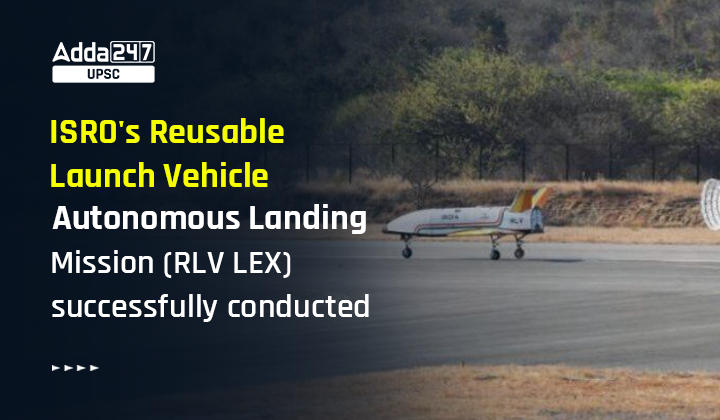Table of Contents
Reusable Launch Vehicle Autonomous Landing Mission (RLV LEX): ISRO’s RLV-LEX is a part of ISRO’s efforts to develop RLVs, or space planes/shuttles, which can travel to low earth orbits to deliver payloads and return to earth for use again. Reusable Launch Vehicle Autonomous Landing Mission (RLV LEX) is also important for UPSC Prelims 2023 and UPSC Mains Exam (GS Paper 3- Development in the field of science and technology; Indigenization of Technologies).
Reusable Launch Vehicle Autonomous Landing Mission (RLV LEX) in News
Recently, Shri Narendra Modi, the Prime Minister, has expressed his satisfaction over ISRO’s successful execution of the Reusable Launch Vehicle Autonomous Landing Mission (RLV LEX).
Reusable Launch Vehicle Autonomous Landing Mission (RLV LEX)
Reusable Launch Vehicle Autonomous Landing Mission (RLV LEX) is a part of ISRO’s efforts to develop RLVs, or space planes/shuttles, which can travel to low earth orbits to deliver payloads and return to earth for use again.
- The successful execution of the Reusable Launch Vehicle Autonomous Landing Mission (RLV LEX) took place at the Aeronautical Test Range (ATR) in Chitradurga, Karnataka.
- ISRO conducted Reusable Launch Vehicle Autonomous Landing Mission (RLV LEX) test successfully with active the participation of DRDO and Indian Air Force.
- ISRO’s recent experiment with the RLV marks the second instance of such a test, almost seven years after the successful technology demonstration of the RLV-TD (HEX) mission, which was also conducted by ISRO on May 23, 2016.
- The RLV successfully carried out approach and landing maneuvers utilizing the Integrated Navigation, Guidance, and Control system, ultimately achieving an autonomous landing on the ATR airstrip. This accomplishment by ISRO marks the successful autonomous landing of a space vehicle.
ISRO’s RLV TD Project Details
ISRO has stated that the winged RLV-TD experiments are aimed at developing fundamental technologies required for creating a completely reusable launch vehicle, which will make space access more affordable.
- The experiments will focus on areas such as-
- Hypersonic flight (HEX),
- Autonomous landing (LEX),
- Return flight experiment (REX),
- Powered cruise flight, and
- Scramjet Propulsion Experiment (SPEX) to facilitate the development of these technologies.
- The RLV-TD developed by ISRO has an appearance similar to that of an aircraft, with a fuselage, nose cap, double delta wings, and twin vertical tails.
- In 2016, ISRO conducted an experiment involving the launch of a winged spacecraft into space using a conventional solid booster engine (HS9).
- The spacecraft reached a speed of Mach 5 (equivalent to five times the speed of sound) during re-entry into the earth’s orbit and covered a distance of 450 km before successfully splashing down in the Bay of Bengal.
Tracing the Journey of ISRO’s RLV project
ISRO had announced one of the initial trials of an RLV in 2010, but it was postponed due to technical difficulties. In 2015, ISRO had also hinted at another RLV trial, but it was also delayed due to technical issues.
- The RLV development program at ISRO was not the primary focus in recent years due to the agency’s attention being directed towards the development of the GSLV and its advanced variant, the GSLV-Mk III.
- This was aimed at enabling ISRO to establish its presence in the profitable market for launching large communication satellites weighing over 2,000 kg.
- However, on May 23, 2016, the first RLV-TD trial was conducted by ISRO.
- ISRO’s RLV LEX test that was conducted recently was second such trial under its RLV Project.
Significance of RLV project
These shuttles will have the capability to transport payloads to low earth orbits and return to earth, and the success of this mission brings ISRO closer to achieving this goal.
- The high costs associated with space exploration have been a significant obstacle to its progress.
- However, reusable launch vehicles are regarded as a dependable, cost-effective, and easily available means of achieving space access.
- The structure of a space launch vehicle accounts for roughly 80 to 87 percent of its total cost, with propellant costs being comparatively insignificant.
- The utilization of RLVs can lead to a cost reduction of approximately 80 percent compared to current launch costs.
What is ISRO’s IMAT Test for Gaganyaan Program? | Parachute Drop Test
What is ISRO’s IMAT Test for Gaganyaan Program? | Parachute Drop Test



 TSPSC Group 1 Question Paper 2024, Downl...
TSPSC Group 1 Question Paper 2024, Downl...
 TSPSC Group 1 Answer key 2024 Out, Downl...
TSPSC Group 1 Answer key 2024 Out, Downl...
 UPSC Prelims 2024 Question Paper, Downlo...
UPSC Prelims 2024 Question Paper, Downlo...




